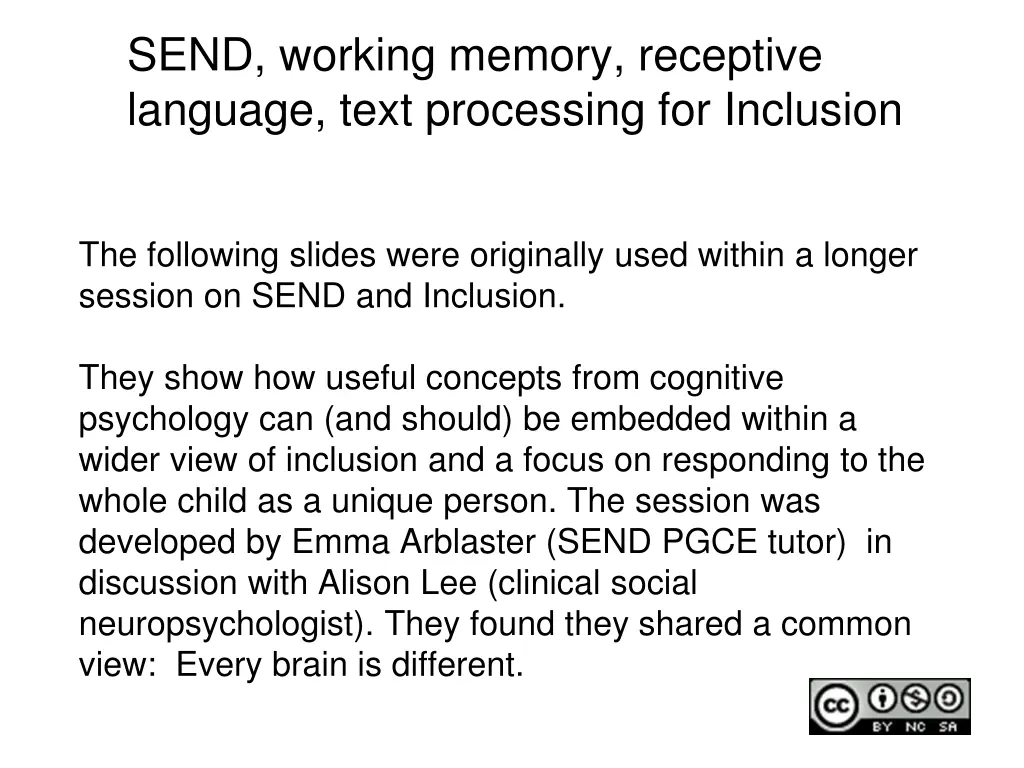
Embedding Cognitive Concepts for Inclusion: Understanding SEND and Learning Disabilities
Explore how cognitive psychology concepts can enhance inclusion practices for individuals with Special Educational Needs and Disabilities (SEND) and learning disabilities. Learn about the importance of responding to each unique individual within a broader view of inclusion. Discover insights on working memory, receptive language, text processing, and strategies for overcoming barriers to inclusion.
Download Presentation

Please find below an Image/Link to download the presentation.
The content on the website is provided AS IS for your information and personal use only. It may not be sold, licensed, or shared on other websites without obtaining consent from the author. If you encounter any issues during the download, it is possible that the publisher has removed the file from their server.
You are allowed to download the files provided on this website for personal or commercial use, subject to the condition that they are used lawfully. All files are the property of their respective owners.
The content on the website is provided AS IS for your information and personal use only. It may not be sold, licensed, or shared on other websites without obtaining consent from the author.
E N D
Presentation Transcript
SEND, working memory, receptive language, text processing for Inclusion The following slides were originally used within a longer session on SEND and Inclusion. They show how useful concepts from cognitive psychology can (and should) be embedded within a wider view of inclusion and a focus on responding to the whole child as a unique person. The session was developed by Emma Arblaster (SEND PGCE tutor) in discussion with Alison Lee (clinical social neuropsychologist). They found they shared a common view: Every brain is different.
Why focus on Inclusion? Because each of the learning disabilities causes a cocktail of challenges Phonological skills Language Processing Memory Sequencing Motor Skills Organisation Literacy Numeracy Self-esteem Behaviour @bathspa_ife
It is hard to diagnose Symptoms of Irlen Syndrome Light Sensitivity Reading Problems Discomfort Attention and Concentration Problems Writing Problems Other Characteristics Depth Perception Distortions Symptoms of Dyslexia Poor spelling Reading slowly or making errors when reading aloud Visual disturbances when reading Difficulty writing Difficulty carrying out a sequence of directions struggling to learn sequences, @bathspa_ife
Therefore, is learning accessible to all? If it was, what would we see? Put another way, if learning was accessible, what wouldn t we see? @bathspa_ife
Barriers to Inclusion pitch of learning language used working memory text accessibility room/lesson organisation independence strategies Really knowing the child or young person guillaumepaumier.com, CC-BY @bathspa_ife
Top 5 strategies for inclusion Always show unconditional, positive regard @bathspa_ife
Limit demands on working memory To learn, children must transfer information from working memory (where it is consciously processed) to long-term memory (where it can be stored and later retrieved). Children have limited working memory capacities that can be overwhelmed by tasks that are cognitively too demanding. Understanding new ideas can be impeded if children are confronted with too much information. @bathspa_ife
Support Receptive Language Watching that experiment, the car was pushed faster by Dillon than Sara. What effect did that have? Before you can go to lunch, I want the children from the red team who wrote their letter first and the green team whose letters were about the Queen to write their first sentence on the board. @bathspa_ife
Puzzing est lide que les diffrences neurologiques comme lautisme et de TDAH sont le r sultat de la variation normale et naturelle dans le g nome humain. ... science sugg re des conditions comme l autisme ont une curie peut mesurer la pr valence dans la soci t humaine d j en nous. neurodiversity on ajatus, ett neurologinen eroja kuten autismi ja ADHD johtuu ihmisen genomin normaali, luonnonmukainen vaihtelua. ... tiede osoittaa, kuten autismi on vakaa esiintyvyytt ihmisyhteis n jo vuonna voimme mitata. @bathspa_ife
Give children time to understand text and to process it. Present it clearly. Puzzing est l id e que les diff rences neurologiques comme l autisme et de TDAH sont le r sultat de la variation normale et naturelle dans le g nome humain. ... science sugg re des conditions comme l autisme ont une curie peut mesurer la pr valence dans la soci t humaine d j en nous. neurodiversity on ajatus, ett neurologinen eroja kuten autismi ja ADHD johtuu ihmisen genomin normaali, luonnonmukainen vaihtelua. ... tiede osoittaa, kuten autismi on vakaa esiintyvyytt ihmisyhteis n jo vuonna voimme mitata. @bathspa_ife
Give thinking time @bathspa_ife
Top 5 tips for inclusion 1. Always show unconditional, positive regard. 2. Limit demands on working memory 3. Support receptive language 4. Give time to process well presented text 5. Give thinking time @bathspa_ife
